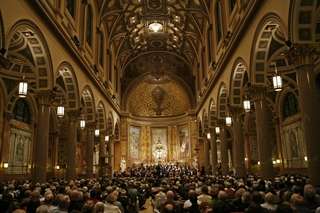|
Back
The ($13 VideoCam) Power and the Glory New York
Church of St. Ignatius Loyola
05/05/2010 -
Claudio Monteverdi: Lactatus sum –
Two Motets: Adoramus te, Christe – Cantate Domino (*)
Igor Stravinsky: Mass (1948)
Arvo Pärt: Miserere – The Beatitudes
Leslie Fagan (Soprano), Virginia Warnken (Mezzo-soprano), Oliver Mercer, Scott Murphree (Tenors), Charles Perry Sprawls (Bass-Baritone), Matt Boehler (Bass)
Choir and Instrumtentalists of St. Ignatius Loyola, Kent Tritle, René Louprette (*) (Conductors)

St. Ignatius Loyola (© Richard Termine)
Unlike many of the Baroque churches in New York built around 1850, nothing is dark or mysterious about the Jesuit Church of St. Ignatius Loyola on Park Avenue. The dimensions are respectful but not overpowering. Daytime sunlight steams down with a heavenly radiance through the multi-colored clerestory windows. At night, the wall colors are a light Sienna Yellow. It is a very welcoming place.
But when I read about the three composers to be presented last night in the series “Sacred Music in a Sacred Place”, the lovely native hues of the church almost dimmed before my ears. Mind you, I love Stravinsky and Monteverdi and Arvo Pärt. But this most holy trio in ensemble might have had a cumulative reaction of blackened mysticism. Not exactly the fires of hell, but sounds which aren’t ordinarily associated with church music.
I’m thinking of the more dramatic, lyrical emotional church music: our Mozart, Verdi, Berlioz, Mendelssohn types or even the pleasantly flat Palestrina masses. Not these three. Monteverdi’s dissonances and angularity can be disconcerting. Stravinsky in 1948 for the Mass was about to enter his Webern period, and much of his music seems so austere that it’s stillborn. And Arvo Pärt, while dazzling, can dismay, even confuse the unprepared listener, leading him/her down ancient archives, archaic apertures. Brrrrr.
Actually, the Estonian composer can connect in churches even more than Monteverdi, not so much with medieval sounds (à la Penderecki) as the sounds of nature and bells, voices a half-tone apart, bass notes from the depths, giving birth to huge choral thunders.
Yes, he can take the easy way, as in the Beatitudes sung here. The “Lord’s Prayer” was effective, but its effect came from one long crescendo from the English-language text, leading to a huge climax. The real excitement, after one hearing, is transient at best.
The Miserere, though, is one of Pärt’s magnificent works, and hearing it in a live performance was highly anticipated. So one must ask why–with four excellent soloists, a small orchestra which made precise sounds in the moderately resonant church, and a fine choir–did conductor Kent Tritle stick them way in the back of the church up in the organ loft for the whole performance?
Auditorially, he may have had a point. One couldn’t complain about the sounds per se, which were uniformly exciting. But our congregation faced the altar, not the organ loft. And in front of the altar was a cheap dingy dinky pull-down screen, the kind of screen made for showing pictures of holidays in Spain after a boring dinner party.
Projected on the screen were live shots from the organ loft. But these images were dimmed and murky. A baritone face would smile and sing, then duck down, a mezzo would arise from the bottom of the screen, sing, smile and duck down. No chorus was shown. The result was like the $13 VideoCam sold at my local grocery shop. And we, the congregation–us–simply were distracted from the glorious music.
While we fiddled, the chorus under Dr. Tritle did burn with energy. The huge organ of the church made amazing sounds, and the tintinnabulation of the bells and brass under the choir made the Miserere potentially wonderful.
Perhaps if this experiment could be tried again, the screen might project religious pictures? Some icons? A South Park episode of Jesus? I don’t have the answer, but neither did the church. One can classify Arvo Pärt as a minimalist, a charlatan, a genius. But he is also so interesting that he needs no cheap effects to make the point.
The first half, though, was a a delight. While I have adoration for Monteverdi the dramatist, his well-balanced church motets are sometimes too sweet. Not, though, the opening Lactatus sum, which was–literally–heaven sent.
(The program states this motet was composed in 1650, and since Monteverdi died in 1643, he obviously had Divine help)
I don’t know the orchestra was originally involved, but here the basses and celli played one four-note theme over and over again, while soprano and mezzo sung in thirds, then tenor and baritone, and last two bass-baritones. This was followed by the entire choir. It was balanced, sung beautifully by all the soloists and fit perfectly into the church.
Stravinsky of course loved Monteverdi and his colleagues, and this Catholic Mass composed by the Russian Orthodox composer, did have its austere Gregorian-chant moments. Instead of the children’s choir, the 12 women of the choir sung, with the non-stringed instruments, under the very deft leadership of René Louprette. Again, within the church, one felt as one feels with few composers, that Stravinsky religiosity was real and profound.
During the intermission, one was honestly moved by sounds which were inexplicably blessed and, frequently sanctifying.
Harry Rolnick
|